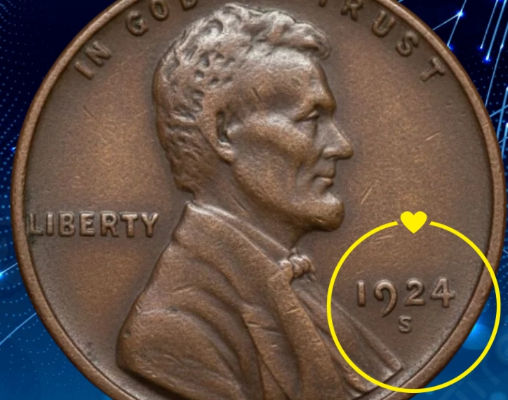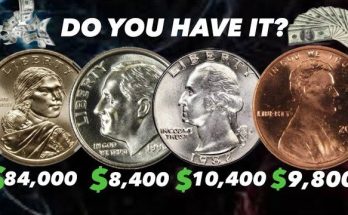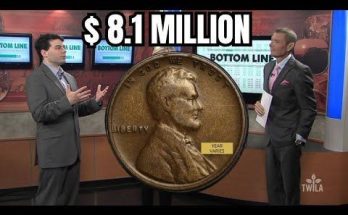Let’s talk about something that might actually be sitting in your pocket change — and could, quite literally, change your financial life. The 1943 Lincoln Wheat Penny has become one of the most legendary coins in American history. And the kicker? A single rare version of this penny can sell for as much as $625,000 today. Sounds unbelievable, right? Well, let’s break down how this tiny piece of copper could be worth more than some houses on the market.
The Unusual Year: 1943 and the Steel Penny Story
To truly understand the value behind this coin, you’ve got to go back to World War II. In 1943, the United States Mint was under pressure — copper was needed for the war effort, primarily for ammunition and wiring. So, in an unusual move, the Mint decided to make pennies out of zinc-coated steel instead of the traditional copper.
Millions of these 1943 steel pennies were produced — they’re grayish, magnetic, and much lighter than the regular copper ones. However, a few copper planchets (that’s the blank discs used to make coins) from 1942 accidentally got stuck in the coin presses when production switched over. When they got stamped with the 1943 date, a few rare 1943 copper pennies were born.
And that small mistake created one of the most valuable error coins in U.S. history.
Why This Penny Is So Valuable
To be fair, not every 1943 penny is special — only those made of copper are. The steel ones are neat collectibles, but they’re usually worth just a few bucks. The 1943 copper version, though, is an entirely different story.
Here’s why:
- Rarity: Only about 20–40 authentic copper 1943 pennies are known to exist today.
- Historical Context: It’s a direct result of wartime resource shifts — a tangible link to American history.
- Collector Demand: Numismatists (coin collectors) are willing to pay huge sums for coins that combine rarity, story, and condition.
In top-notch condition — what experts call “Mint State” — these coins can sell for $625,000 or more. Even those with a bit of wear have sold for over $100,000.
A Real-Life Example That Turned Heads
Back in 2010, one of these famous copper 1943 pennies fetched $1.7 million at auction. Another was sold by Heritage Auctions for $372,000, and yet another brought home around $204,000. Each time one surfaces, it causes a stir among collectors and investors alike.
What’s fascinating is that sometimes these coins are found purely by accident — in old coin jars, estate sales, or even in family collections passed down over generations. Imagine stumbling upon one in a dusty old box and realizing it’s worth more than your car.
How to Tell If You Have One
Now, before you start dumping out your coin jar, let’s talk about identification. The easiest way to check is with a magnet. Since most 1943 pennies are made of steel, they’ll stick to it. A real copper 1943 penny won’t.
Here’s a quick table to help you out:
| Feature | Regular 1943 Steel Penny | Rare 1943 Copper Penny |
|---|---|---|
| Material | Zinc-coated steel | Copper (bronze) |
| Color | Silvery gray | Reddish-brown |
| Magnetic? | Yes | No |
| Weight | About 2.7 grams | About 3.1 grams |
| Estimated Value | $0.10 – $5 | Up to $625,000+ |
Of course, if you think you have one, don’t rush to sell it on eBay. Get it authenticated by a reputable grading service like PCGS or NGC. Their certification adds credibility and value to your find.
The Fascination with Lincoln Pennies
Part of the appeal of Lincoln pennies — especially the older Wheat-backed ones (1909–1958) — is nostalgia. They connect generations. Kids used to collect them, grandparents held onto them, and today, they’re miniature historical artifacts.
Collectors adore the subtle variations: double dies, mint marks, and metal changes tell the story of American minting over time. But the 1943 copper penny stands above the rest — not just as a coin, but as a fluke of history turned treasure.
Could You Actually Find One Today?
Honestly, yes — but it’s a long shot. Most of the known ones have already been documented and traded among collectors. That said, it’s not impossible. Every so often, someone finds one unexpectedly.
For example, a California teenager found a 1943 copper penny in his lunch money back in 1947. He held onto it for decades — and decades later, his coin sold for over $200,000. Not a bad return on a penny, right?
So, while the odds are slim, it never hurts to check your change.
It’s crazy to think that a one-cent coin — something we all overlook — could be worth hundreds of thousands of dollars. But that’s what makes collecting coins so fascinating. It’s not just about money; it’s about history, rarity, and the thrill of discovery.
The 1943 Lincoln Wheat Penny stands as a perfect reminder that sometimes, the smallest things hold the greatest value. So, next time you’re sorting through coins, maybe pause a second longer. That old penny might just be your golden ticket.
FAQs
1. Why were 1943 pennies made of steel instead of copper?
Because copper was needed for military equipment during World War II, so the Mint switched to using steel coated with zinc.
2. How many 1943 copper pennies exist?
It’s believed that fewer than 40 authentic ones exist across all U.S. mints (Philadelphia, Denver, and San Francisco).
3. How can I tell if my 1943 penny is copper or steel?
Use a magnet — steel ones stick, copper ones don’t. Also, copper coins appear brownish-red, while steel ones are grayish.
4. Where can I sell a rare 1943 copper penny?
Major auction houses like Heritage Auctions, Stack’s Bowers, or PCGS-certified dealers are the best options.
5. What’s the highest recorded sale for a 1943 copper penny?
One sold for around $1.7 million, depending on condition and mint mark.



